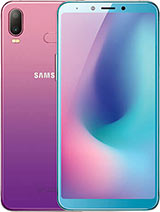Samsung Galaxy A6S Radiation Levels
Display
6.0 inches, 92.9 cm2 (~77.9% screen-to-body ratio)
Camera
Dual Camera: 12 MP, PDAF
2 MP, depth sensor
Hardware
Qualcomm SDM660 Snapdragon 660 (14 nm)
Storage
64/128 GB, 6 GB RAM
Samsung Galaxy A6S - SAR Levels
| Network | Technology | GSM / HSPA / LTE |
| 2G bands | GSM 850 / 900 / 1800 / 1900 – SIM 1 & SIM 2 |
| 3G bands | HSDPA 850 / 900 / 1900 / 2100 |
| 4G bands | LTE |
| Speed | HSPA 42.2/5.76 Mbps, LTE-A (2CA) Cat6 300/50 Mbps |
| GPRS | Yes |
| EDGE | Yes |
| Launch | Announced | 2018, October |
| Status | Available. Released 2018, November |
| Body | Dimensions | 156.1 x 76.4 x 8.4 mm (6.15 x 3.01 x 0.33 in) |
| Weight | – |
| SIM | Hybrid Dual SIM (Nano-SIM, dual stand-by) |
| Display | Type | Super AMOLED capacitive touchscreen, 16M colors |
| Size | 6.0 inches, 92.9 cm2 (~77.9% screen-to-body ratio) |
| Resolution | 1080 x 2160 pixels, 18:9 ratio (~402 ppi density) |
| Platform | OS | Android 8.0 (Oreo) |
| Chipset | Qualcomm SDM660 Snapdragon 660 (14 nm) |
| CPU | Octa-core (4×2.2 GHz Kryo 260 & 4×1.8 GHz Kryo 260) |
| GPU | Adreno 512 |
| Memory | Card slot | microSD, up to 512 GB (uses SIM 2 slot) |
| Internal | 64/128 GB, 6 GB RAM |
| Main Camera | Dual | 12 MP, PDAF
2 MP, depth sensor |
| Features | LED flash, panorama, HDR |
| Video | 2160p@30fps, 1080p@30fps |
| Selfie camera | Single | 12 MP |
| Video | |
| Sound | Loudspeaker | Yes |
| 3.5mm jack | Yes |
| | – Active noise cancellation with dedicated mic |
| Comms | WLAN | Wi-Fi 802.11 a/b/g/n/ac, dual-band, Wi-Fi Direct, hotspot |
| Bluetooth | 5.0, A2DP, LE |
| GPS | Yes, with A-GPS, GLONASS, BDS, GALILEO |
| USB | 2.0, Type-C 1.0 reversible connector |
| Features | Sensors | Fingerprint (rear-mounted), accelerometer, gyro, proximity, compass |
| Battery | | Non-removable Li-Ion 3300 mAh battery |
| Misc | Colors | Black, White, Blue, Pink, Red |
| Price | About 270 EUR |
Samsung Galaxy A6S - QuantaCase™
Samsung Galaxy A6S - FCC SAR Report Image
Samsung Galaxy A6S - Videos
Samsung Galaxy A6S - Offers







